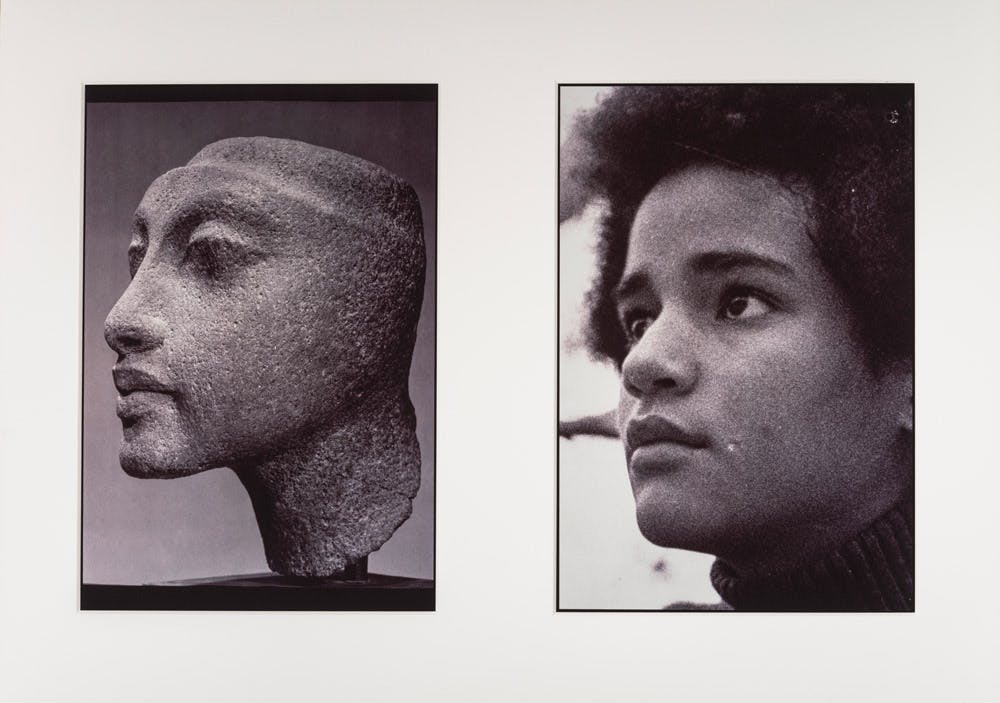Barbara Jones-Hogu
(1938–2017)Vibrant colors, rhythmic compositions, bold lettering, and subjects inspired by people of African descent are the key elements of Barbara Jones-Hogu’s prints.
Biography
Barbara Jones-Hogu studied various forms of printmaking—etching, lithography, screenprinting, wood engraving, and woodblock printing—at the School of the Art Institute of Chicago and the Institute of Design at the Illinois Institute of Technology.
A lifelong resident of Chicago, Jones-Hogu was a founder of the African Commune of Bad Relevant Artists (AfriCOBRA), a collective of Black artists formed in 1968 during the civil rights and Black Power movements. She and other founders had been associated with the earlier Organization of Black American Culture (OBAC), best known for the 1967 Wall of Respect mural in the Bronzeville neighborhood of Chicago. At a time when Black artists were coming together in solidarity, AfriCOBRA created a visual language and philosophy that defined a Black aesthetic, one that emphasized self-determination and empowerment of people across the African diaspora.
Jones-Hogu also embraced printmaking as a means to create works with positive images that fostered confidence and uplifted Black communities. Her training as a printmaker helped establish the AfriCOBRA aesthetic, with works such as One People Unite and Unite becoming emblematic of the group’s oeuvre.
Jones-Hogu earned a BA at Howard University, a BFA at the School of the Art Institute of Chicago, and an MA from the Institute of Design in Chicago. She also earned an MA in printmaking from the Illinois Institute of Technology. In her seventies, she pursued an MFA in independent film and digital imaging at Governor’s State University. Jones Hogu’s work was featured in the Studio Museum exhibitions Impressions/Expressions: Black American Graphics (1979); Tradition and Conflict: Images of a Turbulent Decade 1963–1973 (1985); and Regarding the Figure (2017). Her work entered the Studio Museum’s permanent collection in 1976.
Exhibitions and Events
Barbara Jones-Hogu
(1938–2017)Vibrant colors, rhythmic compositions, bold lettering, and subjects inspired by people of African descent are the key elements of Barbara Jones-Hogu’s prints.
Black Men We Need You, 1971
Biography
Barbara Jones-Hogu studied various forms of printmaking—etching, lithography, screenprinting, wood engraving, and woodblock printing—at the School of the Art Institute of Chicago and the Institute of Design at the Illinois Institute of Technology.
A lifelong resident of Chicago, Jones-Hogu was a founder of the African Commune of Bad Relevant Artists (AfriCOBRA), a collective of Black artists formed in 1968 during the civil rights and Black Power movements. She and other founders had been associated with the earlier Organization of Black American Culture (OBAC), best known for the 1967 Wall of Respect mural in the Bronzeville neighborhood of Chicago. At a time when Black artists were coming together in solidarity, AfriCOBRA created a visual language and philosophy that defined a Black aesthetic, one that emphasized self-determination and empowerment of people across the African diaspora.
Jones-Hogu also embraced printmaking as a means to create works with positive images that fostered confidence and uplifted Black communities. Her training as a printmaker helped establish the AfriCOBRA aesthetic, with works such as One People Unite and Unite becoming emblematic of the group’s oeuvre.
Jones-Hogu earned a BA at Howard University, a BFA at the School of the Art Institute of Chicago, and an MA from the Institute of Design in Chicago. She also earned an MA in printmaking from the Illinois Institute of Technology. In her seventies, she pursued an MFA in independent film and digital imaging at Governor’s State University. Jones Hogu’s work was featured in the Studio Museum exhibitions Impressions/Expressions: Black American Graphics (1979); Tradition and Conflict: Images of a Turbulent Decade 1963–1973 (1985); and Regarding the Figure (2017). Her work entered the Studio Museum’s permanent collection in 1976.





